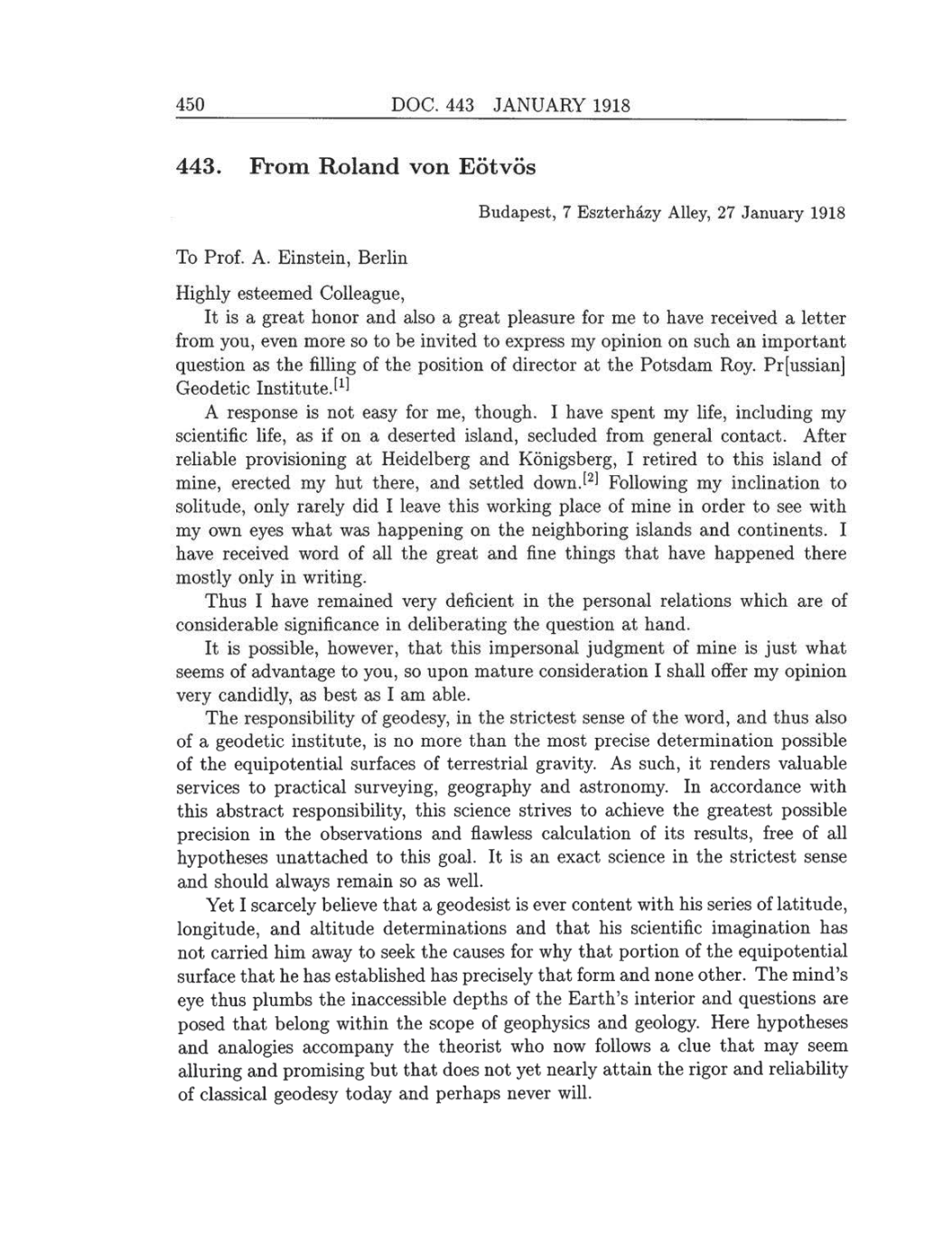450 DOC.
443
JANUARY
1918
443.
From Roland von Eötvös
Budapest, 7 Eszterházy
Alley,
27 January 1918
To Prof.
A.
Einstein,
Berlin
Highly
esteemed
Colleague,
It
is
a
great
honor and also
a
great
pleasure
for
me
to have received
a
letter
from
you,
even more so
to be invited
to
express my opinion
on
such
an
important
question
as
the
filling
of
the
position
of director at
the Potsdam
Roy. Pr[ussian]
Geodetic Institute.[1]
A
response
is
not
easy
for
me, though.
I
have
spent my
life,
including my
scientific
life, as
if
on a
deserted
island,
secluded from
general
contact.
After
reliable
provisioning
at
Heidelberg
and
Königsberg,
I
retired
to
this
island of
mine,
erected
my
hut
there,
and
settled
down.[2]
Following my
inclination
to
solitude, only rarely
did
I
leave
this
working place
of mine in order
to
see
with
my
own eyes
what
was
happening
on
the
neighboring
islands and continents.
I
have received word
of all
the
great
and
fine
things
that
have
happened
there
mostly only
in
writing.
Thus
I
have remained
very
deficient in
the
personal
relations which
are
of
considerable
significance
in
deliberating
the
question
at
hand.
It
is
possible, however,
that this
impersonal
judgment of
mine
is just
what
seems
of
advantage
to
you,
so
upon
mature consideration I
shall
offer
my opinion
very candidly, as
best
as
I
am
able.
The
responsibility
of
geodesy,
in the strictest
sense
of
the
word,
and thus
also
of
a
geodetic
institute, is
no more
than the
most
precise
determination
possible
of
the
equipotential
surfaces of
terrestrial
gravity.
As such,
it renders valuable
services
to practical
surveying, geography
and
astronomy.
In accordance
with
this abstract
responsibility,
this
science strives to achieve
the
greatest
possible
precision
in
the
observations and
flawless
calculation
of
its
results,
free of all
hypotheses
unattached
to
this
goal.
It
is
an
exact science in
the strictest
sense
and
should
always
remain
so as
well.
Yet
I
scarcely
believe
that
a
geodesist
is
ever
content
with
his series of
latitude,
longitude,
and altitude
determinations
and
that
his scientific
imagination
has
not carried
him
away
to seek
the
causes
for
why
that
portion
of
the
equipotential
surface
that he has established has
precisely
that
form and
none
other.
The
mind’s
eye
thus
plumbs
the
inaccessible
depths of
the
Earth’s interior and
questions
are
posed
that
belong
within
the
scope
of
geophysics
and
geology.
Here
hypotheses
and
analogies accompany
the
theorist
who
now
follows
a
clue
that
may
seem
alluring
and
promising
but that
does not
yet nearly
attain the
rigor
and
reliability
of classical
geodesy
today
and
perhaps
never
will.
